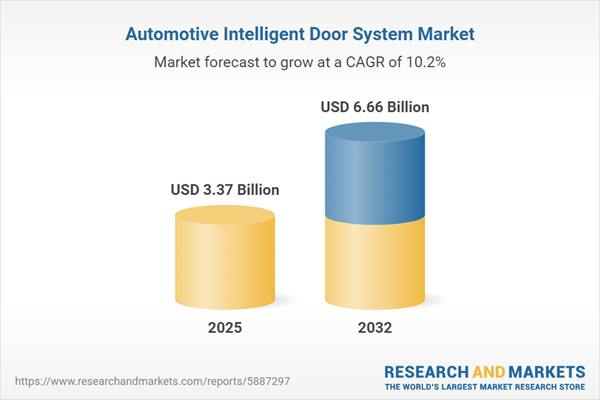Speak directly to the analyst to clarify any post sales queries you may have.
Automotive intelligent door systems are redefining competitive benchmarks for forward-looking manufacturers. As digitalization accelerates and operational models shift, these technologies are enabling safer, more intuitive, and compliant vehicle access, helping senior executives achieve differentiation in dynamic mobility markets.
Market Snapshot: Automotive Intelligent Door System Market
The Automotive Intelligent Door System Market expanded from USD 3.06 billion in 2024 to USD 3.37 billion in 2025, with projections of reaching USD 6.66 billion by 2032 at a CAGR of 10.20%. This growth trajectory is propelled by intensifying demand for advanced safety features, seamless access, and stricter compliance needs. The market is witnessing a pronounced evolution from basic mechanical hardware toward integrated electronic platforms, effectively enhancing user experience and operational capabilities in passenger cars, buses, and commercial vehicles. Transformative adoption is observed worldwide, as stakeholders in every region seek resilient, efficient, and user-centric solutions.
Scope & Segmentation of the Automotive Intelligent Door System Market
Precise segmentation supports both strategic investment and innovation. Automotive leaders benefit by aligning product portfolios, logistics, and R&D priorities with market realities through targeted segmentation. Recognizing core opportunities in fast-digitizing applications, sustainable supply chains, and regionally nuanced compliance factors further sharpens organizational agility.
- Product Types: Central locking systems, electromechanical locks, magnetic locks, and keyless entry methods, including proximity, remote, card, and smartphone-enabled access, each engineered for varying security needs and user expectations.
- Applications: Passenger vehicles, buses, coaches, and commercial fleets, allowing tailored solutions based on vehicle class durability and usage patterns.
- Technology Categories: Camera-based sensors, ultrasonic, laser, and infrared components, powering adaptive and reliable automatic door functionality and refined access management.
- End-User Channels: Collaborative OEM relationships and aftermarket support—from authorized to independent service centers—provide flexible scaling and sustained adoption.
- Sales & Distribution Channels: Offline methods such as direct, multi-brand, and specialty retail, alongside online e-commerce and manufacturer platforms, broadening market reach and adaptability.
- Regional Focus: Americas, Europe, Middle East & Africa, and Asia-Pacific, each distinguished by local regulatory frameworks, consumer preferences, and differing supply chain sophistication, which influence specification and deployment choices.
Key Takeaways for Industry Leaders: Automotive Intelligent Door System Market
- Sensor technologies, including camera, infrared, and ultrasonic platforms, deliver more adaptive and reliable vehicle access, strengthening occupant safety and operational consistency.
- Software supporting remote firmware updates accelerates feature rollouts and aligns with digital transformation goals, minimizing operational slowdowns and maximizing uptime.
- Integration of mobile-based access solutions fosters deep connectivity with digital platforms, underscoring the value of robust technology partnerships and continuous ecosystem alignment.
- Electromechanical systems allow for quieter door operation and straightforward integration into both mainstream and high-end vehicles, standardizing user experience across market segments.
- Component standardization and upskilled service teams streamline installations and enable predictable fleet expansion, which is critical for operators scaling with new vehicle technologies.
- Emphasizing modular design and local production partnerships builds in supply chain agility, helping organizations react swiftly to regulatory, cost, or trade developments.
Tariff Impact on Intelligent Door Systems
Forthcoming US tariffs are shaping sourcing and production strategies across the sector. Organizations are accelerating localization and nearshoring to curb cost pressures and protect operating margins. Strengthening ties with regional suppliers and tailoring product variants to local market standards enhance both resilience and compliance. Both OEM and aftermarket participants are emphasizing modularity and collaborative supplier engagement to outperform under evolving tariff scenarios.
Methodology & Data Sources
Our analysis integrates direct executive interviews, technical audits of actuation systems, thorough supplier documentation, and real-world operational analytics. Layered with up-to-date regulatory reviews and scenario modeling, this approach arms strategy and operational teams with actionable and verified insights.
Why This Report Matters for Decision-Makers
- Drives swift alignment with shifting customer and supplier demands, supporting strategic adaptation in key automotive territories.
- Reveals clear segmentation and multi-channel opportunities for investment targeting, partner engagement, and risk-informed growth planning.
- Helps leadership leverage modular platforms, digital service models, and comprehensive aftermarket strategies for durable excellence in flexible market contexts.
Conclusion
This comprehensive market research report strengthens executive decision-making in a shifting landscape. Harnessing advanced intelligent door technologies supports both persistent operational performance and ongoing product relevance in the face of continued regulatory and customer evolution.
Additional Product Information:
- Purchase of this report includes 1 year online access with quarterly updates.
- This report can be updated on request. Please contact our Customer Experience team using the Ask a Question widget on our website.
Table of Contents
3. Executive Summary
4. Market Overview
7. Cumulative Impact of Artificial Intelligence 2025
Samples

LOADING...
Companies Mentioned
The key companies profiled in this Automotive Intelligent Door System market report include:- Magna International Inc.
- Continental AG
- DENSO Corporation
- FORVIA
- Hirotec Corporation
- Aisin Seiki Co., Ltd.
- Ronstein Automation Technology Co., Ltd.
Table Information
| Report Attribute | Details |
|---|---|
| No. of Pages | 186 |
| Published | October 2025 |
| Forecast Period | 2025 - 2032 |
| Estimated Market Value ( USD | $ 3.37 Billion |
| Forecasted Market Value ( USD | $ 6.66 Billion |
| Compound Annual Growth Rate | 10.2% |
| Regions Covered | Global |
| No. of Companies Mentioned | 8 |









